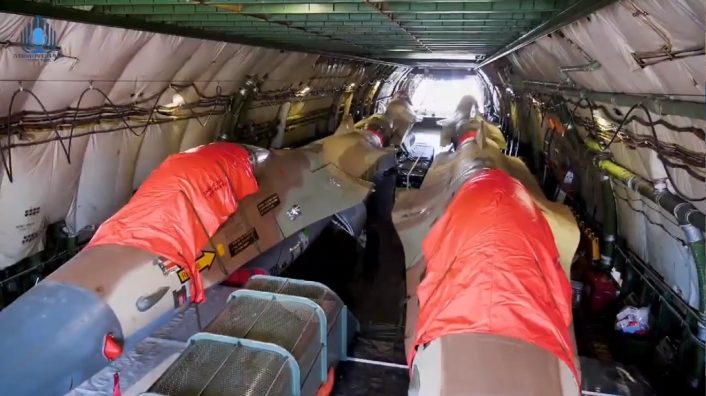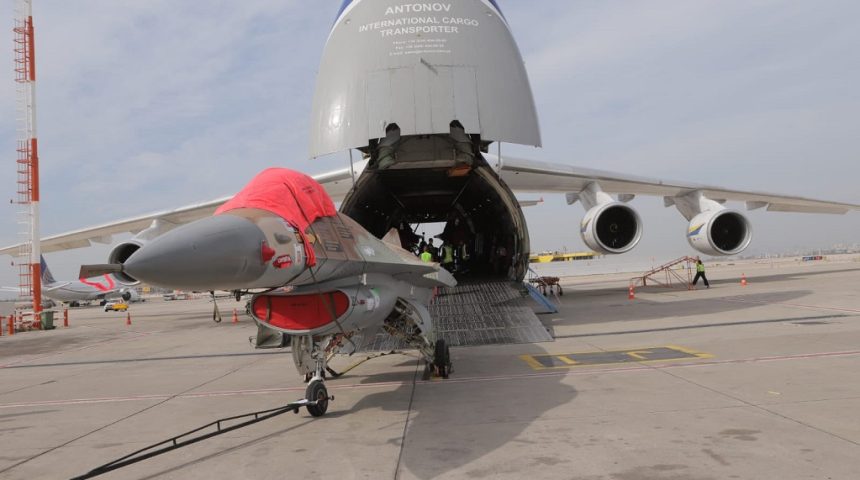The Top Aces jets will operate out of Mesa airport providing the USAF with the first contracted 4th gen. aggressors.
The Canadian company Top Aces received the first four F-16 Fighting Falcons, out of a total order of 29 aircraft, bought from the Israeli Air Force to be used to provide adversary training to the U.S. Air Force, becoming the first company to provide a 4th gen. aircraft for this role. The company, which already operates Alpha Jets, A-4N Skyhawks and Learjet 35As, will base the new jets at Mesa, Arizona, home of their U.S. headquarters.
מטוסי קרב מסוג F16 (“נץ”) של חיל האוויר הישראלי לשעבר, מועמסים בשעה זו על אנטונוב An124 ענקי, שייקח אותם לבעליהם החדשים בקנדה. ההמראה מתוכננת ל- 15 אחה”צ. דרך צלחה 🇮🇱🇨🇦@ynetalerts pic.twitter.com/oZDGbED5YY
— איתי בלומנטל Itay Blumental (@ItayBlumental) January 27, 2021
The four F-16s, with their wings, tail and tailerons removed, were loaded on a Ukrainian Antonov An-124 at Tel Aviv-Ben Gurion airport on January 27 and, after a stop in Keflavik, Iceland, they arrived a day later at Phoenix-Mesa Gateway airport.
The first reports about this deal surfaced last year, with Jordan mentioned as the source for the F-16s. The reports, however, proved to be wrong, with the Israeli Ministry of Defense acknowledging the unprecedented sale of 29 F-16 Netz (Hawk), as they are locally known, which were retired from the Israeli Air Force at the end of 2016, after 36 years of service.
Following negotiations led by SIBAT, the MoD has signed an unprecedented agreement to supply 29 F-16 aircraft to TOP ACES. These will be employed as staged adversary aircraft in U.S. Air Force training. pic.twitter.com/SHwPwp2FYI
— Ministry of Defense (@Israel_MOD) January 28, 2021
Even if the tails were removed, it is possible to identify the four aircraft thanks to the serials painted on the side of the air intake:
- F-16B Block 5, Lockheed Martin serial 6W-8, USAF serial 78-0362, IAF serial 017;
- F-16A Block 5, Lockheed Martin serial 6V-15, USAF serial 78-0322, IAF serial 129;
- F-16A Block 10B, Lockheed Martin serial 6V-20, USAF serial 78-0327, IAF serial 220;
- F-16A Block 10B, Lockheed Martin serial 6V-39, USAF serial 78-0346, IAF serial 250.
According to the website F-16.net, the aircraft were first sold to Iran through the Peace Zebra Foreign Military Sale (FMS), which was then cancelled in 1979 along with the sale of the E-3A and RF-4. The aircraft were then redirected to Israel a year later through the Peace Marble I FMS.
All the aircraft saw extensive operational use, wearing also celebratory marks that seem to have been removed, however, before the sale. The first one to be noticed is Netz 129, which was involved in Operation Opera in 1981. The aircraft was reportedly the fourth of the eight F-16s to drop its bombs on Iraq’s Osirak nuclear reactor. This F-16 also has a shared air-to-air victory with Netz 107, having downed a Syrian MiG-23 with an AIM-9L Sidewinder during the Israeli–Lebanese conflict on June 9, 1982, according to the book “The Sword of David: The Israeli Air Force at War”, by Don McCarthy, and other online sources.
עם כל הכבוד לרביעיית המטוסים, הציוץ הזה מוקדש ל”נץ” מספר 129, שיצא ב- 7 ביוני 1981 במבנה “אזמל” לתקיפת הכור הגרעיני בעיראק במסגרת מבצע “אופרה”. כאן בצילום היסטורי ממבצע התקיפה ולידו תמונות מהעמסתו על האנטונוב אתמול pic.twitter.com/8XKG12AHdy
— איתי בלומנטל Itay Blumental (@ItayBlumental) January 28, 2021
Netz 220 was flown by Israeli Ace Amir Nachumi when it obtained its kill mark, shooting down a Syrian MiG-21 with an AIM-9L on June 9, 1982. Netz 250 has two kill marks, a MiG-23 and a MiG-21, both with Sidewinders on June 8 and 11, 1982, respectively (some sources claim that the second kill may have happened on June 9 instead).
The Israeli F-16s have been upgraded locally through the years, reportedly receiving similar capabilities to the F-16C and also a new cockpit with three Multi-Function Displays (MFD), Helmet Mounted Display (HMD) and an upgraded Head-Up Display (HUD), in addition to Israeli avionics and Electronic Warfare (EW) suites. It is not known if any of these features have been removed before the sale, however Top Aces’ press release mentions that “the upgraded fleet of F-16s are able to employ an Active Electronically Scanned Array (AESA) radar, helmet-mounted cueing system, tactical datalink and high off boresight missile capability to provide unparalleled adversary air training”.

Top Aces was awarded an indefinite delivery, indefinite quantity contract in 2019 to “provide complete contracted air support services for realistic and challenging advanced adversary air threats and close air support threats”, as part of the Combat Air Force/Contracted Air Support (CAF/CAS) program.
As already explained, the original Combat Air Force Contracted Air Support (CAF CAS) multi-award contract, was announced to cover 40,000 flight hours of adversary training at 12 different air bases and 10,000 flight hours is support of Joint Terminal Attack Controllers (JTAC) training at nine Army bases. After some reductions, the current program’s first phase features a little less than 9,000 flight sorties at six bases for the first year and an optional three year-extension for a total of over 26,000 flight sorties.
The six bases involved are Kingsley Field ANGB (TacAir), Luke AFB (ATAC), Holloman AFB (ATAC), Eglin AFB (ATAC), Seymour Johnson AFB (Draken) and Kelly Field (Draken), home of FTUs for F-15s, F-16s, F-22s and F-35s. The Air Force is wishing to provide the same adversary support to all air bases, but due to the budget it was decided to prioritize training bases.
Top Aces was not among the initial round of contract awardees, however the press release mentioned that they will begin providing adversary training for the USAF, U.S. Navy and DoD in 2021 under the 2019 indefinite delivery, indefinite quantity contract.
As an interesting sidenote, Netz 220 and 250 before their retirement served in the 115 Squadron, also known as the Flying Dragon or Red Squadron, the dedicated aggressor squadron of the Israeli Air Force. The other two F-16s were assigned to the 116 Squadron, also known as The Lions of the South, which was reopened last year as the second F-35I Adir Squadron.









